Once upon a time, there was a python woman named Kuniya. One day, her gut told her that something bad has happened, to her nephew. Without any hesitation, she started immediately on the long journey through the desert to see him.
On the other side of the desert, the nephew lay with an injury, a spear pierced his thigh. He had foolishly said something to hurt the sentiments of Liru warriors of south west, and they punished him in their traditional way. With lesson taught, they left one of their warriors behind to care for him until he healed. The warrior however neglected his duty. By the time Kuniya reached, it was too late.
She decided to teach the Liru warrior a lesson for his neglect, and challenged him to a duel. He instead chose to mock her. In response, she started dancing, while he looked on bewildered. The dance mustered all her anger into poison, which spread quickly into the air weakening him. She struck his head with a stick first, but her anger hasn’t dissipated. With another strike, she killed him. She then returned to her original form and disappeared into the rock, only visible as a small black line to the visitors of Uluru. The entire story is evidenced on the walls of Uluru.
Stories I believe are a reflection of the collective consciousness and thought process of a place. Like this very short story of Kuniya. It talks of a women’s intuitive strength, something rarely acknowledged in today’s times.
Uluru dates back to over 500 million years! Come to think of it, that’s almost 250 million years before dinosaurs were known to have existed. Its no wonder then that Uluru dream time stories talk of giant creatures that existed whose footprints formed massive craters on it’s rock.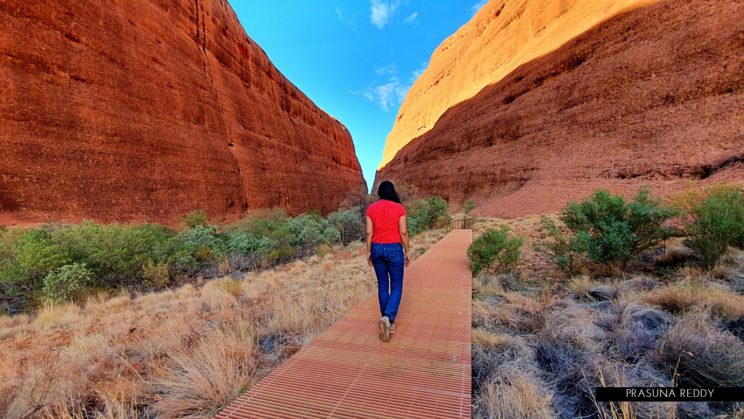 Long before I managed to visit this iconic landmark, I saw myself sitting in it’s red rustic land and watching the sunset with a glass of red wine. Although I spent a decade’s time in Australia, Uluru was still on the cards. You see, in my head, Uluru was this perfect escape that I wanted to experience the right way with meticulous planning. Life though seemed to have other plans, as always!
Long before I managed to visit this iconic landmark, I saw myself sitting in it’s red rustic land and watching the sunset with a glass of red wine. Although I spent a decade’s time in Australia, Uluru was still on the cards. You see, in my head, Uluru was this perfect escape that I wanted to experience the right way with meticulous planning. Life though seemed to have other plans, as always!
So it happened that when I decided to escape after a rough day at work, the only flights in my budget were to Uluru. Another friend jumped in and we booked the tickets instantly. Thanks to no prior planning, hotels were sold out, and so seemed hire cars. A few hours and many calls later, we confirmed a non-powered camp site and a Mitsubishi Outlander. The next stop, Kmart (thankful to it’s longer hours) for a tent, sleeping bag and camping supplies. Outback Australia, here we come! Or almost didn’t, thanks to an uber driver that kept circling around my block for 25 minutes, but saved by another uber driver that dropped me at airport in record time.
Once we arrived in Uluru though, everything seemed perfect. We picked our hire car, headed to Ayers Rock Campground and set up the tent. The whole process took us less than an hour much to our surprise. With a lot of time ahead, we set about exploring the small town. Later in the evening, we were on our way to the national park to see Uluru’s famed sunset.
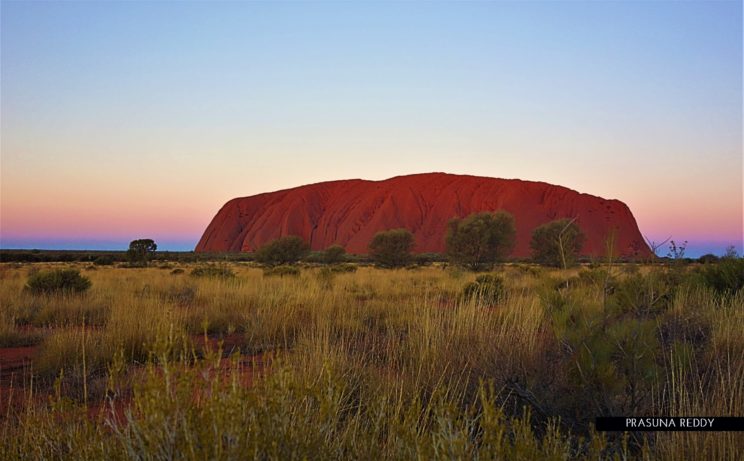
Copper Sulfate blue rising from the sky soon after the sunset!
The first sight of Uluru is quite remarkable to say the least. You’ve seen it in so many pictures and think you know what to expect, but you don’t. The sheer magnificence of it takes you by surprise. We just screamed together, and all exclamations fell short!
Once the initial euphoria settled, we chose a comfortable spot and sat down with the rest of the crowd. As someone who chased sunsets for a long time, I believed that I had seen all its’ variants, and familiar with every hue of orange/red there ever was. I was in for a surprise. As the sun started setting, from the background, a rich blue seemed to start rising in the sky, first a slim line at the horizon almost easy to miss, and within minutes reaching half of the rock. The rock transformed along with the background. This was one of the most unique sunset experiences ever, and boy, it was beautiful!
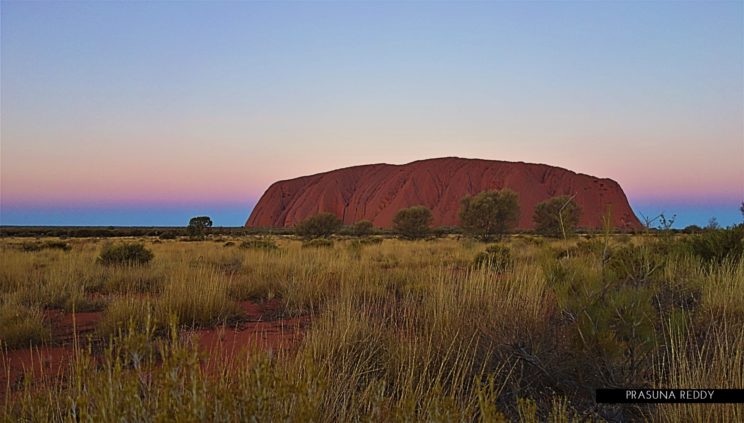
Still kept rising as it got darker
Our day couldn’t have been more perfect if we tried. And the night even better with an unobstructed view of the milky way. I was glad that the hotels were not available. Camping is the only way to experience the outback. We settled into our layers of warm jackets and watched the night sky.
We made it in time for a beautiful sunrise view the following morning. We decided to skip heading back to camp and hit the Uluru Base Walk trail. The rangers run sessions for visitors every morning and thankfully, we were there at the perfect time.
The full magnitude of the rock only hit us once we were at its base. It was easy to underestimate it’s size from far away. To me, it’s no wonder the Anangu regarded it as Sacred. I mean, who wouldn’t. It was pure magnificence that stood on the flat red desert for over 550 million years.
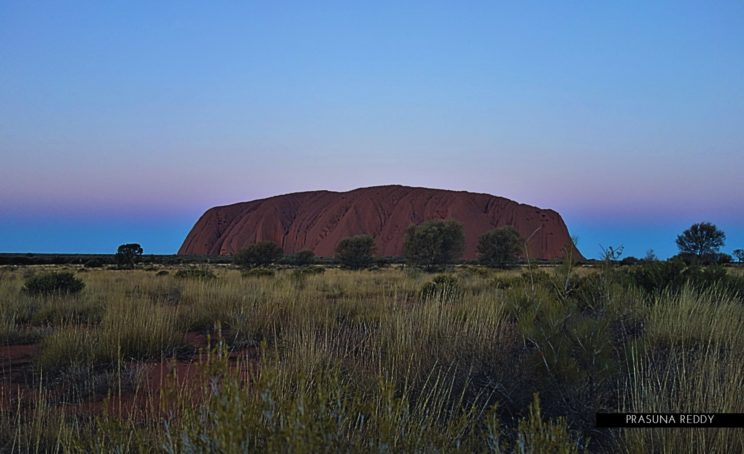
Almost covered the rock
I saw several people climbing Uluru. Calling it ‘climbing’ is fairly generous I guess, crawling seems more apt. This was despite multiple signs saying that the Anangu consider the monolith sacred and it hurts their sentiments to see people climb it. When a ranger was in sight, I asked the question that was bothering me “why is the government allowing people to climb it.” He replied, “it’s legal to climb, but the law is changing in October, and hence there’s more crowd before it is shut down.”
I know it’s not the first someones’ feelings, customs or traditions are trampled on. But in a developed country that boasts itself of better quality of life and human rights, you’d assume that hurting someone’s sentiments and faith would be reason enough to not climb!
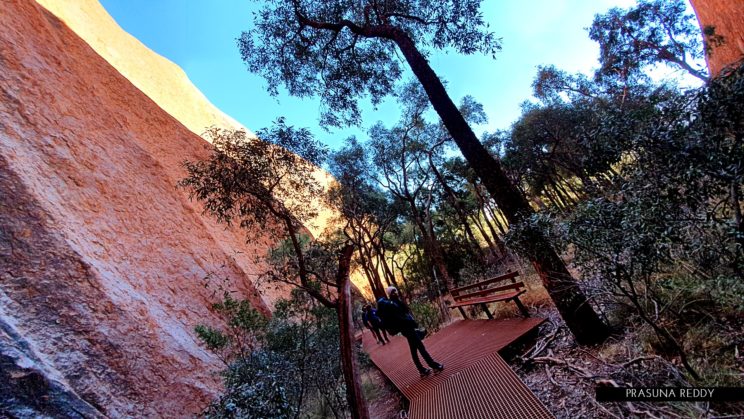 We carried on with the trail walk and listened to the stories of Anangu people, their gathering places, teaching styles, role of elders etc. The many mythical stories of Anangu seemed to carry a treasure trove of knowledge and wisdom to protect themselves and their way of life. From healing techniques, to directions to find water in the desert or hunting a game, the stories seemed to have it all.
We carried on with the trail walk and listened to the stories of Anangu people, their gathering places, teaching styles, role of elders etc. The many mythical stories of Anangu seemed to carry a treasure trove of knowledge and wisdom to protect themselves and their way of life. From healing techniques, to directions to find water in the desert or hunting a game, the stories seemed to have it all.
We walked for over 2 hours in the heat and swarming flies, carrying 2 liters of water and fruit, and our car conveniently parked nearby if needed. In contrast, the locals of this region traversed the length and breadth of this desert thousands of years ago with no compass to navigate, no communication, and no bottles to carry cool water, instead relying on their hunting skills and getting to the waterhole before dehydration set in, hoping the waterhole didn’t dry up.
My favorite trail was the Mutijulu Waterhole. Not only because it’s green cover contrasted the red rock beautifully, but moreso for an aura of peace and serenity around this place.
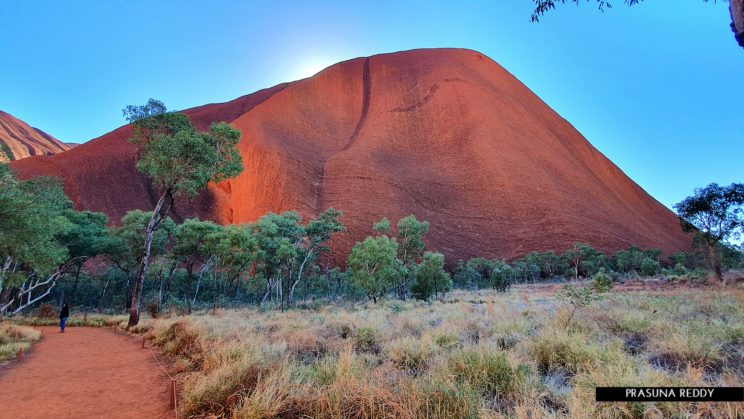 The following day, we headed to Kata Tjuta, a place of many domes, unlike the monolithic structure. Only then did I find out that, whilst Uluru and Kata Tjuta are miles apart, they are part of a much larger underground rock formation.
The following day, we headed to Kata Tjuta, a place of many domes, unlike the monolithic structure. Only then did I find out that, whilst Uluru and Kata Tjuta are miles apart, they are part of a much larger underground rock formation.
Kata Tjuta has several trails. My favorite was the Walpa Gorge trail nestled between two giant domes. Its the kind of place where you would want to sit and meditate, soak it’s age old silence and wisdom and admire the vastness of nature.
The sunset of Kata Tjuta to me was no match to Uluru. But as we were returning, in my rear view mirror I saw the most magnificent colors of the sky on a flat red land. I couldn’t help but turn and drive towards the sunset. It was one of the most remarkable drives and moments of this journey. The best part was that we had it all for ourselves, not a soul for miles.
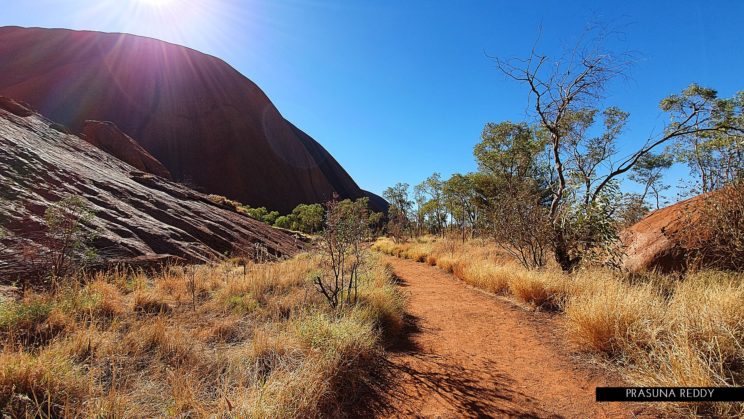
As more and more people wake up to sustainability and inevitable climate crisis, I hope we do work at reversing the damage we did in the name of civilized society. Before the knowledge of tribes like Anangu disappears, lets hope we have a chance to learn from them.